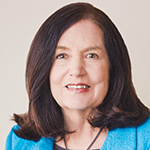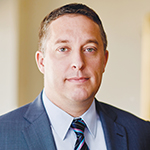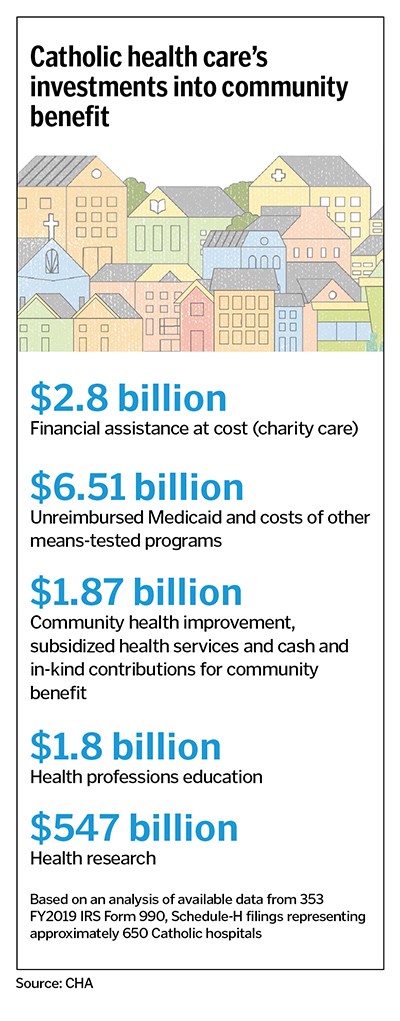Community benefit, a driving force behind the Catholic health ministry's current mission, may have its roots in the 1700s when a congregation of women religious came from Europe to America to visit and aid the sick and the poor.
 Trocchio
Trocchio"They looked around and saw what needed to be done. ... You could say they were doing the first community health needs assessments," Julie Trocchio, CHA's senior director of community benefit and continuing care, said during an online briefing for congressional staffers on community benefit requirements for not-for-profit hospitals hosted by CHA Sept. 7.
 Swanepoel
SwanepoelLucas W. Swanepoel, senior director of government relations, in explaining why CHA offered the briefing, noted that the association has been a leader in establishing community benefit best practices. "At a time when there is increasing scrutiny around hospital community benefit programs, we hope to use this expertise, and work of the Catholic health ministry, to break through the noise and confusion about the tax requirements that not-for-profit hospitals must abide by," Swanepoel said.
He added that the briefing provided an opportunity to remind congressional staff of the current legal requirements and demonstrate the many ways not-for-profit hospitals take these requirements seriously in their work to serve those in need in their community.

Picking and choosing
A tax expert from Ernst & Young LLP and representatives from Franciscan Missionaries of Our Lady Health System and CHRISTUS Health spoke during the briefing.
The presenters explained that community benefit is a well-defined set of activities that tax-exempt hospitals must do to maintain their status as tax-exempt entities under federal law.
Stephen Clarke, managing director of the exempt organization tax services division of Ernst & Young, noted the community benefit standard was established by the IRS in 1969. The Affordable Care Act in 2010 added more requirements, such as having hospitals adopt and promote a financial assistance policy and do a community health needs assessment every three years. It also limited certain charges and collections actions.
Clarke detailed the eight types of reportable community benefits, including research, health professions education, and financial assistance or at-cost charity care. He noted that nonprofit hospitals and their community benefit standards have received increased media attention over the past year.
"Interestingly, most of these press outlets or research groups don't report on all eight types of community benefit, but they pick and choose categories that they think are community benefit or charitable," he said. "Oftentimes, only a couple or a few of those categories are highlighted by the press."
 Barrett
BarrettTop 10 needs
Coletta Barrett, vice president of mission at Our Lady of the Lake Regional Medical Center in Baton Rouge, Louisiana, talked about her hospital system's affiliation with Healthy BR, a mayoral initiative to address the health of the community. Our Lady of the Lake is part of FMOLHS.
All five of the major hospitals that serve the Baton Rouge region are part of the initiative and collaborated to create a community health needs assessment. "We may have individual implementation strategies, but we all report into the same implementation plan," she said. "Therefore, we can focus our efforts on those key priorities and move the needle on some of these community strategies."
The hospitals analyzed data and talked to people in the community to identify the top 10 needs of the community, which included access to care and prevention of cancer, diabetes and sexually transmitted diseases. "By focusing on areas of improvement and collectively working in our own ways, we're able to address significant population health issues in Baton Rouge," Barrett said.
 Pesquera
PesqueraFrom surveys to programs
Marcos Pesquera, system vice president of community health and health equity and chief diversity officer at CHRISTUS Health, talked about his health system's work in underserved communities and focused on the Corpus Christi region in Texas.
CHRISTUS made surveys about community needs available in both printed and online formats. The system got about 500 responses in at least seven languages from the Corpus Christi region alone, Pesquera said.
One of the many programs the system implemented in response is a food prescription program, in which medical providers refer patients and eligible community members to a food bank or to get monthly food boxes. They are then asked to schedule a follow-up medical visit after they are enrolled. "It's been quite a success," Pesquera said.
The hospital system also uses AmeriCorps workers as community health program coordinators to maintain data on resources to help community partners. Those workers are based at the partner organizations, "which is great because they can deal with the public, with the community and with their peers," Pesquera said. "That's how we're able to integrate all of our programs throughout the community."
Resources related to community benefit requirements are available at chausa.org/communitybenefit. In addition, CHA is offering the three-day program Community Benefit 101 Oct. 24-26. Information is at chausa.org/events.